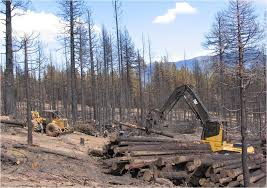 Given the many large fires in recent decades and the many ecosystem values that people want from forests, post-fire salvage logging will continue to be a controversial timber treatment. The results of post-fire logging can vary greatly from place to place because post-fire logging varies in number and size of trees left, whether the largest trees and green trees are left or removed, the equipment used to log, the timing of the logging, and the limits imposed on road building and logging to minimize site impacts.
Given the many large fires in recent decades and the many ecosystem values that people want from forests, post-fire salvage logging will continue to be a controversial timber treatment. The results of post-fire logging can vary greatly from place to place because post-fire logging varies in number and size of trees left, whether the largest trees and green trees are left or removed, the equipment used to log, the timing of the logging, and the limits imposed on road building and logging to minimize site impacts.
Opinions on post-fire salvage logging vary greatly. Proponents of salvage logging after fire emphasize the need for prompt harvest because the economic value of timber declines rapidly in fire-damaged trees. Opponents of salvage logging worry that this is adding ‘insult to injury’ by imposing logging with attendant soil disturbance and soil erosion potential. Ecologists express concern that cavity-nesting birds and other wildlife can be negatively affected by harvesting, particularly if logging is extensive and few trees are left.
The publications and media in this hot topic address the effects of salvage logging on plants, biodiversity, and cavity-nesting birds. They also cover a range of research that includes, but is not limited to, the ecological impacts of salvage logging; the effects of salvage logging on soil, sediment production, mountain pine beetles, and riparian systems.
This hot topic was developed in partnership with the University of Idaho.
Recorded Webinars
Technical Reports/White Papers
- Landscape evaluations and prescriptions for post-fire landscapes
- Mixed-severity fire and salvage logging in dry forests of Oregon's western Cascades
- Literature review: effects of salvage logging on riparian zones in coniferous forests of eastern Washington and adjacent regions
- Effects of timber harvest following wildfire in western North America
- Responses of cavity-nesting birds to stand-replacement fire and salvage logging in ponderosa pine/douglas-fir forests of southwestern Idaho
- Wildfire and salvage logging: recommendations for ecologically sound post-fire salvage logging and other post-fire treatments on federal lands in the West
- Deterioration of fire-killed and fire-damaged timber in the Western United States